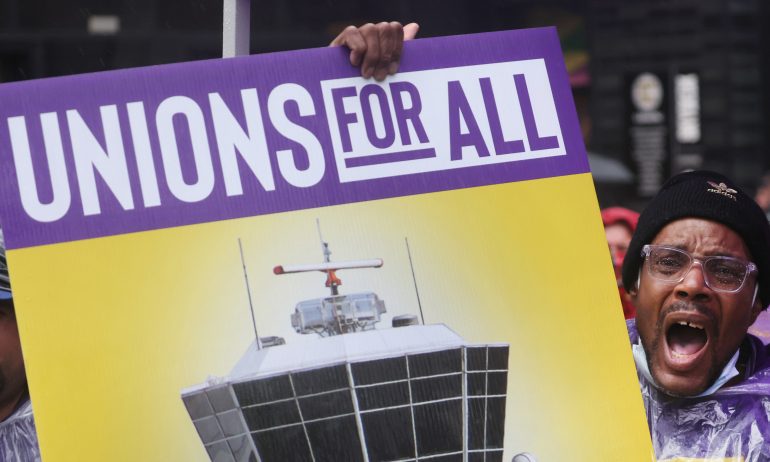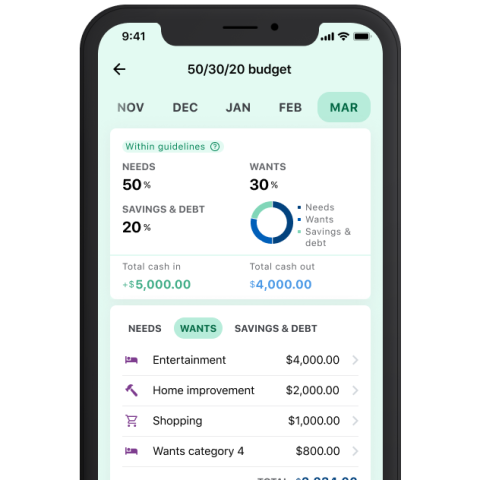What Is a Union and How Does a Union Work?

Many or all of the products featured here are from our partners who compensate us. This influences which products we write about and where and how the product appears on a page. However, this does not influence our evaluations. Our opinions are our own. Here is a list of our partners and here's how we make money.
Updated on Jan. 23 with 2023 data on union membership from the Bureau of Labor Statistics.
A union is a group of workers who join together to negotiate with an employer over pay, benefits, scheduling, and other workplace policies and conditions. The process of negotiating with an employer as a unified entity is known as collective bargaining, and it gives workers some power to set the terms of their employment.
Workers who are not members of a union earn about 14% less than workers who do belong to a union, according to the most recent data from the Bureau of Labor Statistics.
About 14.4 million workers were part of a union in 2023, according to the BLS. And interest in unionizing appears to be increasing, in part because of recent successes.
On the heels of a major strike by the United Auto Workers that ended with a robust improvement to workers' pay and other conditions, the union is now organizing non-union workers from a dozen other auto manufacturers to join their ranks.

How do unions work?
A group of workers interested in bargaining collectively with their employer can organize a new, independent union or join an existing union. After a group agrees to unionize, the union can negotiate a collective bargaining agreement — a legally binding contract between the union and employer.
Forming a union
To form a union, workers must take a couple of official steps to both show interest in forming a union and gain that recognition from their employer. Here’s how they can do that.
Voluntary recognition. A majority of employees can sign union authorization cards, which are forms that record a person’s interest in a union. At that point, workers can request recognition as a union from the employer, and the employer can voluntarily do so.
A majority vote in an election. If the employer doesn’t voluntarily recognize the union, but at least 30% of employees sign union authorization cards, the employees can file a petition for an election conducted by a labor agency such as the National Labor Relations Board (NLRB), which is tasked with protecting workers’ rights to collective bargaining.
If the majority of employees vote to unionize, the labor agency will certify the group as a union. Then the employer is required to bargain with the union in good faith.
The NLRB conducted 1,482 elections in 2023 and unions won 71% of those elections. Compare that to 1,363 elections in 2022 and unions won 76% of those elections.
The size and scope of each union varies. For example, you may have seen the International Brotherhood of Teamsters in the news over the past year; it represents more than 1.2 million people in a wide array of occupations across the U.S., Canada and Puerto Rico, according to its website.
The Teamsters union represents 340,000 UPS workers, and over the summer it negotiated a deal with UPS after threatening a strike.
Joining a union
In a unionized workplace, union membership is optional. All workers covered by a collective bargaining agreement are known as a bargaining unit, and workers don’t have to be union members to be part of the bargaining unit.

Union members pay dues, participate in union activities and agree to follow union rules. Dues are used to fund union operations, including paying staff, lobbying and supporting members during a strike.
Someone who opts out of union membership may still have to pay a portion of union dues to cover the cost of collective bargaining. However, in 26 states with “right-to-work” laws, workers can’t be required to pay fees to a union as a condition of employment. Even then, those workers are still covered by the collective bargaining agreement.
An employer may work with multiple unions representing different bargaining units in its workforce. For example, public schools may have contracts with one union representing teachers and another representing clerical or janitorial staff.
Negotiating as a union
A union’s main purpose is negotiating a collective bargaining agreement. These contracts typically cover pay, benefits, time off, working conditions and worker protections.
Union members play a role in deciding what’s included in a contract. They elect union representatives, vote on what changes to make when contracts are negotiated, and approve new agreements.
When contract talks stall because the union and the employer can’t agree on terms, union members might vote to strike, meaning they refuse to work as a way to compel employers to agree to the union's demands.
What’s covered in a union contract can vary by industry.
Changes in technology were at the root of the contract changes proposed by TV and film writers. The Writers Guild of America (WGA) — a union representing 11,500 screenwriters — went on strike for months this year in part to demand its contract address the impact streaming services have had on compensation and the potential threat artificial intelligence poses to creative professionals.
For unions with members who were on the front lines of the COVID-19 pandemic, understaffing and safety protocols have been a common concern. Those issues have compelled Starbucks workers to unionize at more than 330 U.S. stores since 2021.
In another example, a new contract that the Minnesota Nurses Association negotiated in 2022 gave nurses a say in setting staffing levels, requiring consensus between nurses and management before any staffing reductions take place.
Unions also have used collective bargaining agreements to make “common good” demands — proposals that would impact the community beyond the bargaining unit. For instance, Oakland, California, teachers went on strike in May to secure higher pay and a better schedule, as well as a commitment from the school district to provide support for unhoused students.
How many union workers are in the U.S.?
The Bureau of Labor Statistics report on union membership, released in January 2024, found that the number of unionized workers increased by 139,000 from the previous year.
Despite the year-over-year increase, the percentage of U.S. workers who belong to a union is at a record low. In 2023, 10% of workers belonged to a union, down from 20.1% of workers in 1983, which is the earliest comparable data available from BLS. The 2023 rate of union membership was 0.1 percentage point lower than the previous year.
The union membership rate varies widely between states. States with the highest union membership rates include Hawaii (24.1%) and New York (20.6%). The lowest union membership rates are in South Carolina (2.3%) and North Carolina (2.7%).
The BLS report gives a current portrait of America's union workers:
More public-sector workers belong to a union than private-sector: 32.5% versus 6%, respectively.
Among all public sector fields, union membership rates are highest in local government, which includes positions such as police officers, firefighters and teachers.
Among all private sector fields, union membership rates are highest in utilities; transportation and warehousing; education services; and motion picture and sound recording industries.
Among all occupations those with the highest unionization rates are in education, training and library (32.7%), as well as protective services (31.9%).
Among the sexes, men are more likely to be members of a union than women. The membership rate among men is 10.5% compared with 9.5% of women workers.
By race and ethnicity, Black workers are more likely to be members of a union (11.8%) compared with white (9.8%), Asian (7.8%) or Hispanic workers (9%).
(Photo by Scott Olson/Getty Images News via Getty Images)


